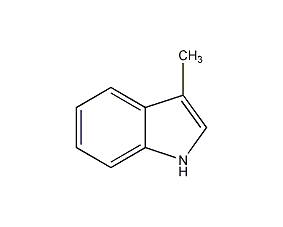
Structural formula
| Business number | 01TQ |
|---|---|
| Molecular formula | C9H9N |
| Molecular weight | 131.17 |
| label |
β-methylindole, skatole, β-Methyl azaindene, β-methyl indole, Skatole, β-methyl-aza-indene, artificial flavors |
Numbering system
CAS number:83-34-1
MDL number:MFCD00005627
EINECS number:201-471-7
RTECS number:NM0350000
BRN number:111296
PubChem number:24896981
Physical property data
1. Character: white or slightly brown crystal.
2. Density (g/mL, 25/4℃): Uncertain
3. Relative vapor density (g/mL, air=1): Uncertain
4. Melting point (ºC): 95℃
5. Boiling point (ºC, normal pressure): Uncertain
6. Boiling point (ºC, 100.7kPa): 265 -266
7. Refractive index: Uncertain
8. Flash point (ºC): 132°C
9. Specific rotation (º): Uncertain
10. Autoignition point or ignition temperature (ºC): Uncertain
11. Vapor pressure (kPa, 25ºC): Uncertain
12 . Saturated vapor pressure (kPa, 60ºC): Uncertain
13. Heat of combustion (KJ/mol): Uncertain
14. Critical temperature (ºC): Uncertain
p>
15. Critical pressure (KPa): Uncertain
16. Log value of oil-water (octanol/water) partition coefficient: Uncertain
17. Explosion upper limit (%, V/V): Uncertain
18. Lower explosion limit (%, V/V): Uncertain
19. Solubility: soluble in hot water, ethanol, Benzene, chloroform and ether. Slightly soluble in water
Toxicological data
Acute toxicity:
Rat caliber LD50: 3450 mg/k
Mouse caliber LD50: 470 mg/kg
Mouse abdominal cavity LD50: 175 mg/kg;
Frog subcutaneous TDL0: 1gm/kg; frog intestinal TDL0: 435mg/kg;
Mammal caliber TDL0: 200mg/kg
Bovine vein LD50: 60 mg/kg;
Ecological data
None
Molecular structure data
1. Molar refractive index: 43.35
2. Molar volume (cm3/mol): 118.1
3. Isotonic specific volume (90.2K ): 308.3
4. Surface tension (dyne/cm): 46.4
5. Polarizability (10-24cm3): 17.18
Compute chemical data
1. Reference value for hydrophobic parameter calculation (XlogP): None
2. Number of hydrogen bond donors: 1
3. Number of hydrogen bond acceptors: 0
4. Number of rotatable chemical bonds: 0
5. Number of tautomers: none
6. Topological molecule polar surface area 15.8
7. Number of heavy atoms: 10
8. Surface charge: 0
9. Complexity: 122
10. Number of isotope atoms: 0
11. Determine the number of atomic stereocenters: 0
12. Uncertain number of atomic stereocenters: 0
13. Determine the number of chemical bond stereocenters: 0
14. Number of uncertain chemical bond stereocenters: 0
15. Number of covalent bond units: 1
Properties and stability
White scale crystals. Animals with feces stink. When concentrated, it is nauseating. It has a jasmine scent when diluted. When extremely diluted, it has the aroma of ripe fruits. Naturally found in feces and civet scent.
Storage method
Stored in a cool and dark place.
Synthesis method
Dilute with phenylhydrazine and benzene, add propionaldehyde benzene solution dropwise with stirring, and react at reflux temperature. After the dropwise addition is completed, continue stirring for 1 hour. When the reaction is completed, water and benzene are evaporated. Collect propionaldehyde phenylhydrazone at 112~117°C (133.3~266.6) Pa under reduced pressure, with a yield of about 90%. Add an appropriate amount of anhydrous zinc chloride to propionaldehyde phenylhydrazone and heat to 180°C to react with deamination and cyclization to obtain the desired product.
Purpose
When used, it is diluted to obtain its fresh floral fragrance. It is an important raw material for preparing jasmine flowers. It can be combined with indole, quinoline and other derivatives to prepare artificial civet balm, and can also be used as a flavoring agent for beverages, candies, chewing gum and other flavors. Product quality: The melting point of the product is 96~96.8℃.

 微信扫一扫打赏
微信扫一扫打赏

